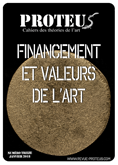Artangel et la commande d’art public au Royaume-Uni au tournant du XXIe siècle. Quand l’hybridation des financements de l’art britannique coïncide avec une hybridation des lieux de l’art
Abstract
 Télécharger l’article
Télécharger l’article
Paru dans : Proteus n°13

Depuis la fin des années soixante, la notion de sculpture publique a été éclipsée par celle d’art public, intervention artistique dans l’environnement, principalement urbain, qui ne se conçoit plus simplement comme une installation sur un site indifférent, mais comme une nouvelle modalité d’occupation d’un lieu – contexte non plus seulement physique, mais également économique, politique et social. La rupture politique avec l’état providence amorcée à la fin des années soixante-dix au Royaume-Uni et son incidence sur les politiques culturelles dorénavant axée sur une hybridation des financements ont transformé la façon dont l’art investi un espace public mondialisé, technologisé et souvent privatisé et donc de moins en moins véritablement public. Le commissariat de ces œuvres a lui aussi connu des bouleversements qui ont encouragé l’émergence d’organismes privés mais soutenus par des fonds publics et dont Artangel est un exemple phare. Leurs commandes d’œuvres depuis leur création en 1985, mais aussi leur façon d’occuper l’espace non-institutionnel, ont contribué à transformer la scène artistique britannique depuis la fin du 20esiècle, ainsi qu’à redéfinir à la fois ce que l’art public peut être aujourd’hui, mais aussi, et de manière tout aussi cruciale, où il peut être.
Mots-clés : politiques culturelles britanniques — maisons — mécénat — philanthropie — espace public
Since the end of the Sixties, the concept of public sculpture has been overshadowed by that of public art, an artistic intervention in the environment, mainly urban, which is no longer considered simply as an unusual setting, but as a new way of occupying space – no longer simply a physical definition of it, but also an economic, political and social one. The political break with the consensus period of the Welfare State which came at the end of the Seventies in Britain, and the impact it had on the country’s cultural policies, from then on geared towards a hybridization of funding, all this transformed the way art occupies new, globalized, technologized, and often even privatized, public spaces. Curating such works has consequently proven more complicated and has given rise to the emergence of a number of private agencies supported in part by public funds, of which Artangel is a prime example. Their often high profile art commissions since they were created in 1985, alongside their distinctive way of using unusual, non-institutional spaces, have contributed to reshaping the British art scene since the end of the 20thcentury, as well as to redefining the notion of public art today, but also, and this is just as crucial, where it can happen.
Keywords: British cultural policies — houses — sponsorship — philanthropy — public space








